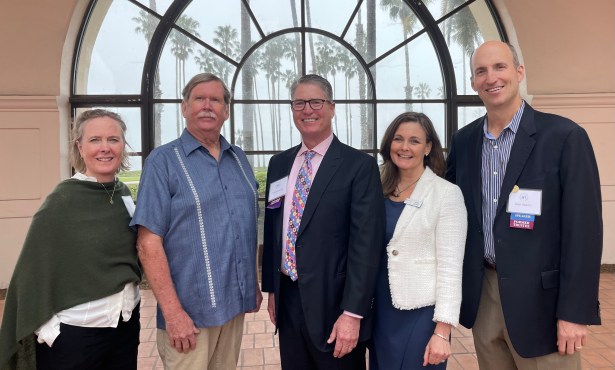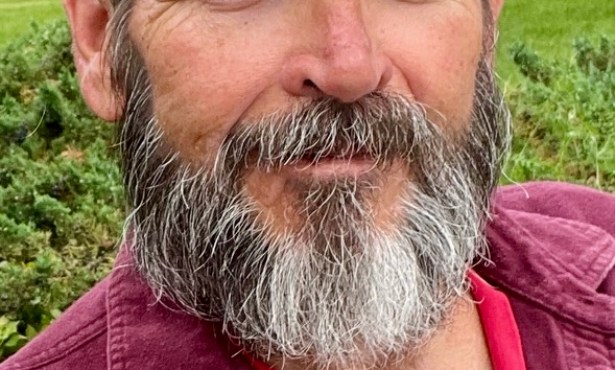A Short History of Skateboarding in Isla Vista
Henry Sarria Recalls the Area's Sidewalk-Surfing Past
On a recent night while I was biking home through UCSB, I saw a now-rare yet familiar sight: Skateboarders trying to “ollie” off the Geology Department stairs by the bike path along Broida Hall. That brought back a flood of memories of Isla Vista’s skateboarding past. It was skateboarding that brought me to this little seaside enclave back in 1985, again in 1986, and it eventually caused me to move up here in 1987. The way I see it, coming here was no accident and the skateboard was a tool of that process.
Santa Barbara has a colorful skateboarding history, and what follows are a few of the area’s contributions to the sport. Sims Skateboards, for instance, was started in Santa Barbara by Tom Sims back in 1975. Barfoot snowboards and skateboard also originate from this area. George Powell started the Quicksilver and Quicktail skateboards in 1976, which were distributed through Sims. Powell eventually teamed up with Stacy Peralta in 1978 to start Powell Peralta. Sims was eventually sold to Vision around 1979, while Powell Peralta became Powell Corporation when Stacy left in 1991, and the company is still located on La Patera Lane in Goleta. There was also Santa Barbara Skateboards as well as Stanton Skateboards, which was started by Bob Stanton around 1975.
Additionally, Tony Bueless started a skateboard hardware company back around 1985 called Shorty’s – the store’s merchandise expanded to include grip tape, skate decks, and clothing, and Bueless eventually moved his operation to downtown Santa Barbara where Church of Skatan was born and stands today. There also used to be the Golf-n-Fun and Sparks skateparks in Goleta. Early skateboarding notables from this area included Doug DeMontmorency, Marc Hollander, Lonnie Toft, Gordie Lineman, and Edie Robertson (just to name a few), all of whom rode for Sims. Marc is still living in the area and is still an awesome skater. Edie was the head chef for Sojourner up until last year and is still a partner in that business.
The reason for my first I.V. visit in 1985 was the annual Beach Shop Streetstyle Contest. Owned by Rob Nall, the Beach Shop used to be on the corner of Pardall and Embarcadero Del Norte (the location is now Isla Vista Surf Company). Held during “dead week” prior to UCSB finals in November, this event featured jump ramps, parking blocks, slide rails, a picnic bench, and a car with a ramp next to it. The event was held on the corner of Trigo Road and Embarcadero Del Mar right in front of the International Food Market. Needless to say, beer sales were sky-high on the weekend of that event. For the contest, the street was closed and some real skating by some of the time’s legends went down in front of huge crowds. After the contest was over and the awards were handed out, the traditional “product toss” was done from the balcony above the market and the scene could only be described as mixture of controlled chaos and feeding frenzy. The last Beach Shop contest was held in 1986 and it was the last amateur event for my fellow Santa Monica Airlines (SMA) teammates Natas Kaupas and Jesse Martinez. Jesse performed the first-ever wall ride done in a contest and upset the odds by winning the event.
Back in that period, there was a hardcore skate presence in Isla Vista. Skaters such as John Chen, Karen Zapata, Brandon Chapman (SMA), Kurt Zapata (Powell Wheels), Ron Allen (H-Street), Frankie Hill and Rob Washburn (Powell/Peralta), John Oliver, Robbie Olhauser, John Lydle, Mike Taylor, Matt Vaughn and Mike Kresky (Team Effigy) were always up for some skating. There were many others, but these guys were the driving force behind the I.V. skate scene and, with this crowd, the skating and the party afterward were always fun.
When I moved to Isla Vista in 1987, the skate scene was still thriving. Local skate spots, which were typically drainage ditches in Goleta, had colorful names such as Flyaway, Walls, and Bayou as well as the popular Flybowl up on Painted Cave Road. These spots, mainly Flyaway, were hit religiously just about every day after work or school.
The great thing about I.V., being a college town full of young people, is that you could always find somebody with the same interests as you, and skateboarding was a huge and universal phenomenon at that time. One of the most commonly hit spots on the UCSB campus was Broida Hall. The planters in front made for great railslides, there was a good set of stairs to ollie off of, and a little curb to grind on. I can remember many fun hours spent there with the crew of diehards and an occasional visit from pros like Tommy Guerrero and Jim Thiebaud who joined in on the fun. Yet another popular skate spot was the Broida Hall’s roof. This spot offered wave-like banks that you could pump, pick up speed from, and get air off of. You just had to make sure you turned before going off the edge of the building or it was a very long fall to the bottom. Other skating spots on campus included the little bank in front of the old University Center, the handrails at the Music Department building, and the planters in front of Campbell Hall. Engineering II was also a good spot, but often a bust.
Another fun aspect about I.V. with regard to skating was the occasional skate ramp that would pop-up every now and then. Some were rickety structures that were a liability to one’s health, while others were perfectly built pieces of art that hosted some of the best skating sessions anybody could imagine. Isla Vista’s lack of free, open space meant that ramps couldn’t be too big for the most part. I can’t tell you how many times I overshot a landing, which would send me flying off the end of the ramp and landing on some unsuspecting bystander. Then again, the boards I used (and still use) for skating ramps and banks are of the “long” variety (at least 36-inches long) and their lines are very drawn out. It was always a juggling act to stay within the confines of an eight-foot-wide ramp while riding those monsters. Also, because of Isla Vista’s close proximities, everybody would eventually find out about your ramp and ride it. So there was no such thing as a “secret ramp.”
One of the most popular ramps back in 1986 was the “Twin’s Ramp” which was built by twins named Nate and Tate, but you had to have an “in” to skate that beauty. The other popular ramp was next to the “Roadhouse” on the corner of Sueno and Camino Corto Streets. This ramp, which lasted from 1995 to 1996, was constantly skated and even ridden with freestyle bikes. Always the spot for a great session, the ramp went from a four-foot mini-ramp section to more substantial section with three or four feet of vertical.
The other popular skate spot from 1993 to 1999 was the Saint Athanasius Church parking lot at the bottom of the Embarcadero loop. It was perfect because the asphalt then was smooth; there were a few painted curbs to grind or slide on as well as little wheelchair access ramps that could be used to launch off of. Every now and then, somebody would bring a jump ramp and the session would heat up. J&S Skate Shop used to be across the street, so one could expect a huge skater hangout and always a fun time. The hot local skater back then was Powell Corporation’s Stacy Lowery, and he was a regular at those parking lot sessions. Of course, nobody can forget the planters in front of the Embarcadero Lecture Hall. The structures there are near vertical, thus offering the possibility of wallrides. There was also the planter on the side of the building where rail slides could go for more than 20 feet, not to mention grinds.
These days you can see a ton of people at Skater’s Point, the skatepark on Santa Barbara’s waterfront area. But the precursor to this effort (aside from Goleta’s Golf-n-Fun and Sparks) was the Powell Skate Zone. It was a full-on wooden skatepark built in one of the bays of the Powell Corporation factory. The company hosted many contests there and the skate sessions were always intense. It eventually shut down in 1994, but I still have my membership card from those days! Guys like George Nagai, Tony Tieu, Sammy Baptista, and Carl Nunez were some of the regulars there, and they always put on a great show of skill.
Things have changed since those bygone days. The Isla Vista skate scene started to dwindle around 1999 when most of the hardcore skaters eventually moved away or took on jobs and families. But you still do see people cruising to class on long boards and the occasional street skater trying to land a flip trick. UC Campus Police have cracked down on “recreational skating” on campus so those long, undisturbed skate sessions at Broida Hall are long gone. There’s talk of the upcoming Isla Vista Skate Zone skate park which is to be located on Estero Road on Isla Vista Recreation and Park District property, but construction of that is some time away and, considering the current economic situation, that project may not be completed for some time. I hope it is built soon, however, as it would be awesome to have a skatepark just around the corner from my home!
As for me, I still skate some local spots, usually by myself with my longboards with the occasional old timers showing up to carve some lines in the banked asphalt. On a refreshing note, during the Christmas break, a couple of guys up the street from me leaned a four-by-eight-foot piece of plywood against the curb by Sueno Park and were doing carves on it. That brought back memories of my skating roots way back in the 1970s and a huge smile to my face. Skateboarding lives on in Isla Vista, but her past was definitely something for hardcore skaters to behold. It wasn’t bad – it’s what got me here in the first place and for that I am truly blessed.



